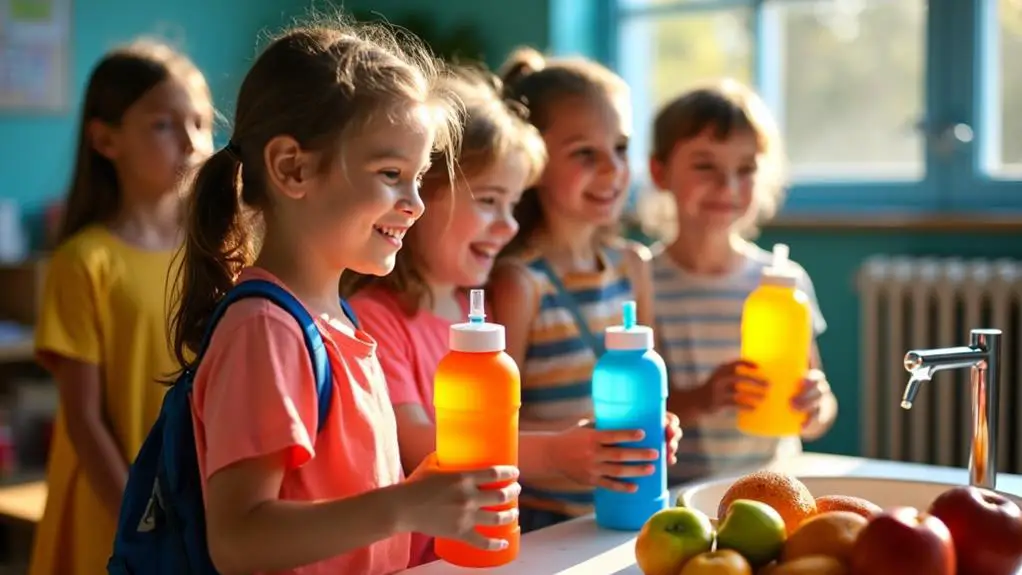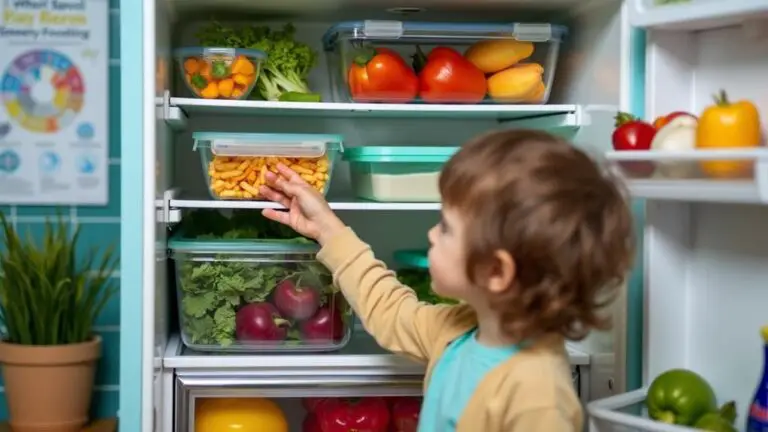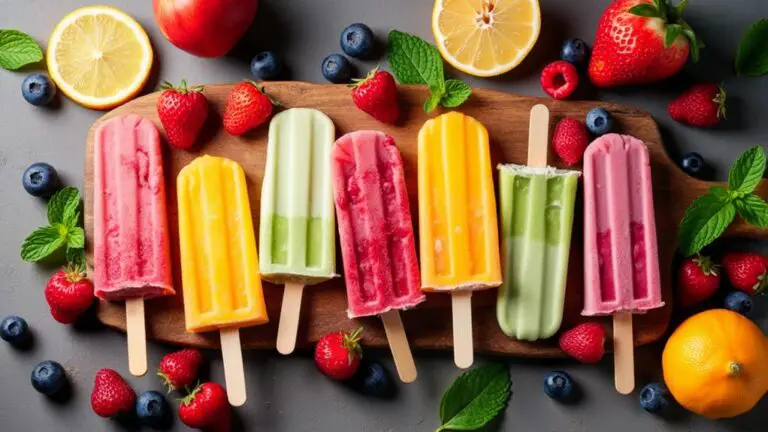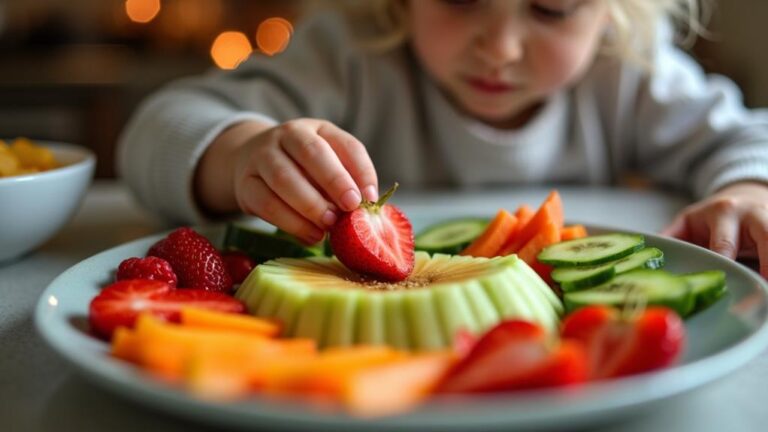Hydration Habits: Encouraging Water Consumption in Children
To encourage water consumption in children, start by understanding their hydration needs based on age and activity level. Make water more appealing by using fun cups or infusing it with fruit. Limit sugary beverages and offer healthier alternatives like unsweetened milk or diluted fruit juices. Model good hydration habits yourself and teach kids to monitor their urine color as an indicator of hydration status. Set reminders for regular water breaks, especially during physical activities or hot weather. By fostering these healthy habits early, you'll help your children develop lifelong practices for proper hydration. Discover more strategies to keep your kids well-hydrated and thriving.
Key Takeaways
- Make water readily available and visually appealing with fun cups or bottles.
- Model good hydration habits by drinking water regularly in front of children.
- Offer water-rich fruits and vegetables as snacks to increase overall fluid intake.
- Teach children to monitor urine color as an indicator of hydration status.
- Gradually replace sugary drinks with water or naturally flavored alternatives.
Understanding Hydration Needs
Water, the essence of life, plays an essential role in children's health and well-being. Understanding your child's hydration needs is essential for their best growth and development.
Children require different amounts of water based on their age, with 1-3-year-olds needing about 4 cups daily, increasing to 7-8 cups for adolescents. It's important to recognize that these needs can vary depending on activity level and climate.
Dehydration can lead to fatigue, headaches, and decreased cognitive function, making proper hydration critical for your child's performance. You'll want to encourage drinking water throughout the day, especially during physical activities and hot weather.
Avoid sugary drinks, as they're less effective at quenching thirst and can contribute to obesity. Monitor your child's urine color; pale yellow indicates adequate hydration, while darker shades suggest a need for more fluids.
Signs of Dehydration
You'll want to be on the lookout for common dehydration symptoms in your children, including dark urine, fatigue, and headaches.
Kids are more susceptible to dehydration than adults, especially during hot weather or illness. To prevent dehydration, encourage regular fluid intake and be proactive about hydration during physical activities.
Common Dehydration Symptoms
Spotting the signs of dehydration in children is vital for their health and well-being. As a parent or caregiver, you'll want to recognize these common symptoms to guarantee proper hydration.
Children may experience:
- Dry mouth and fatigue
- Concentrated, darker urine
- Headache, nausea, and irritability
These symptoms can impair cognitive function and physical performance, especially in active children. During sports or hot weather, kids are at higher risk for dehydration, so it's important to monitor them closely.
Watch for changes in their behavior, energy levels, and urine color. By identifying these signs early, you can intervene quickly and prevent more serious health issues.
Risk Factors
While recognizing dehydration symptoms is important, understanding the risk factors that lead to these signs is equally essential. Children need to stay well hydrated due to their higher body water content and increased physical activity levels compared to adults. They're more susceptible to fluid imbalances, making it vital to monitor their water intake closely.
Certain situations heighten the risk of dehydration in children. Illnesses causing vomiting or diarrhea can rapidly deplete fluid levels, requiring extra vigilance. Hot weather and intense physical activity also increase fluid loss through sweat.
Signs of dehydration, such as dark yellow urine, irritability, and decreased urine output, indicate a disrupted water balance. To prevent these issues, encourage regular fluid intake throughout the day, especially during illness or physical exertion.
Prevention Strategies
Recognizing the signs of dehydration in children is essential for implementing effective prevention strategies. To guarantee your child stays properly hydrated, monitor their hydration habits closely.
Watch for symptoms like:
- Dry mouth
- Fatigue or dizziness
- Dark yellow urine
Encourage your child to drink water regularly, especially during physical activities or hot weather. For vigorous exercise, they may need 3-8 ounces of water every 20 minutes.
Remember, infants under six months should only receive breast milk or formula.
To prevent dehydration, establish good hydration habits early. Teach your child to check their urine color as an indicator of hydration status. Pale yellow suggests adequate hydration, while darker shades mean they need to drink more water.
Age-Based Water Intake Guidelines
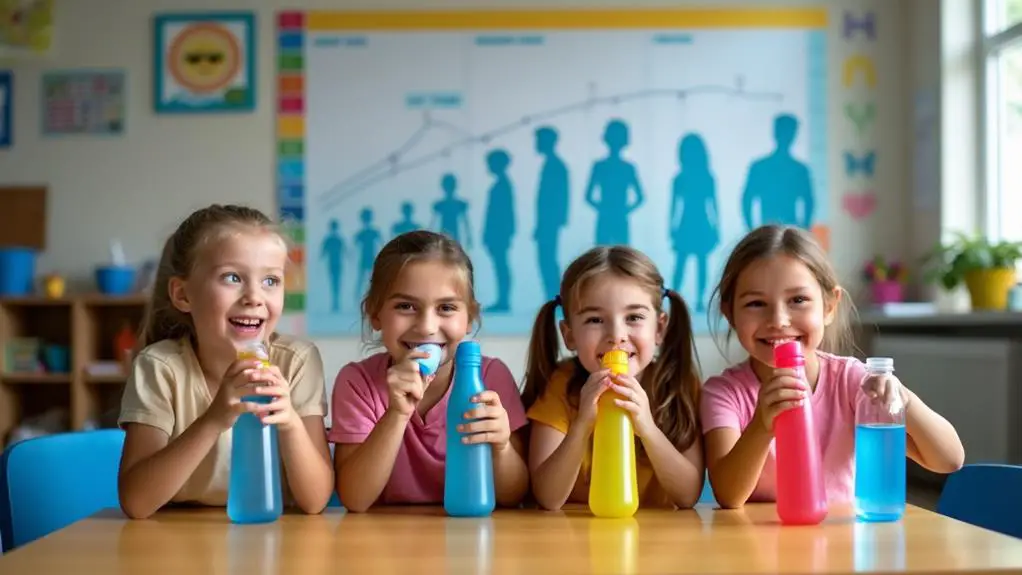
Proper hydration is essential for children's health and development, and the amount of water they need changes as they grow.
To guarantee your child stays well-hydrated, follow these age-based water intake guidelines:
For young children aged 1-3, aim for about 4 cups of fluids daily.
As they grow, increase their water intake to around 5 cups for ages 4-8.
Kids aged 9-13 should drink 7-8 cups of fluids each day to support their growing bodies.
Teenagers need 6-8 cups daily, with more during physical activity or hot weather.
Making Water More Appealing
Getting children to drink enough water can be a challenge, but there are several ways to make it more appealing. You can make sure your child stays hydrated by offering infused water with fruits like lemon or berries. This enhances the flavor and encourages them to drink more.
Serve water in fun, colorful cups or with exciting straws to create positive associations.
To increase fluid intake, try these strategies:
- Offer water-rich fruits and vegetables as snacks
- Create homemade fruit popsicles for hot days
- Provide personalized water bottles for kids to decorate
Be a good role model by drinking plenty of water yourself. Involve your children in choosing their own water bottles or cups, fostering a sense of ownership.
Limiting Sugary Beverages
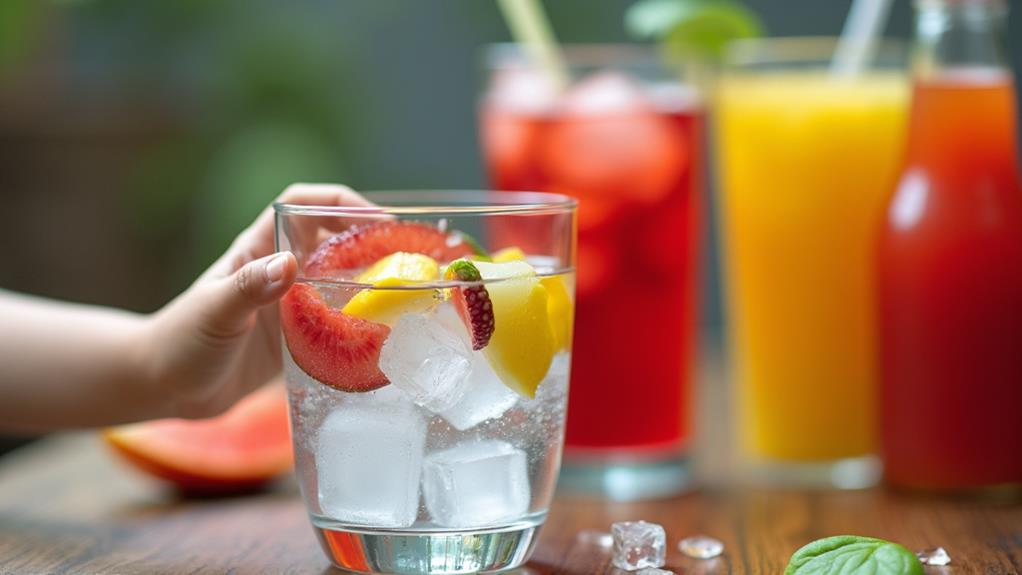
You'll find it easier to limit sugary beverages by offering healthier alternatives like water infused with fruit slices or unsweetened herbal teas.
Gradually reduce the amount of sugary drinks you provide, replacing them with these healthier options over time.
Healthier Drink Alternatives
When it comes to children's hydration, limiting sugary beverages is essential. The American Academy of Pediatrics recommends that kids need to restrict their added sugars intake to less than 10% of daily calories.
Instead of sugary beverages, focus on healthier drink alternatives:
- Water: It's calorie-free and the best option for hydration
- Unsweetened milk: Provides essential nutrients
- Diluted 100% fruit juices: Offer flavor with less sugar
Gradual Reduction Techniques
While offering healthier drink alternatives is important, reducing sugary beverage consumption can be challenging for children. To make this shift smoother, gradually reduce sugary drinks in your child's diet.
Implement a "water-only" guideline during meals and snacks, encouraging them to reach for water bottles instead. Educate your children about the negative effects of excessive sugar intake, such as obesity and dental issues, to motivate them to choose water over sugary options.
Consider using a reward system to make the process more engaging. Offer stickers or small incentives when they opt for water, helping them stay hydrated and avoid becoming dehydrated.
Introduce flavored water alternatives like fruit-infused water or herbal teas to provide satisfying taste without added sugars. By combining these gradual reduction techniques, you'll help your children develop healthier hydration habits and reduce their reliance on sugary beverages.
Fostering Healthy Hydration Habits
Instilling healthy hydration habits in children is essential for their long-term well-being. To help your child drink enough water throughout the day, consider these strategies:
- Model good behavior by choosing water as your primary beverage.
- Teach them to monitor their urine color for hydration status.
- Use colorful cups and straws to make water more appealing.
Engage your child in discussions about why water is a better choice than drinks high in sugar. This will help them understand the importance of staying hydrated and make them less hungry for sugary alternatives.
You can also set reminders or use apps to encourage consistent water consumption, especially during physical activities.
Conclusion
You've now got the tools to help your little ones stay properly "watered." Remember, keeping them hydrated isn't just about avoiding the "dry spells," it's about nurturing their overall well-being. By making H2O more enticing and curbing those "sweet sippers," you're setting them up for success. Stay consistent, and soon enough, reaching for water will become second nature. Your efforts today will bloom into lifelong healthy habits tomorrow.

